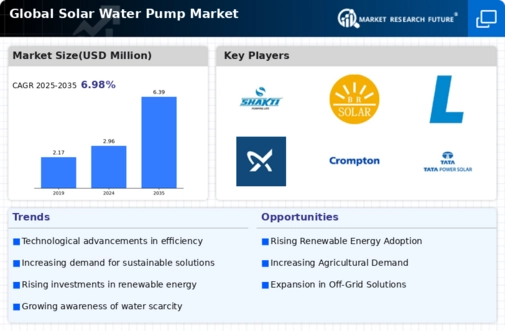Top Industry Leaders in the Solar Water Pumps Market

*Disclaimer: List of key companies in no particular order
Fueled by a growing focus on water security, sustainable energy, and cost efficiency, the solar water pumping market is emerging as a vibrant battleground. Established players and innovative newcomers strive to capture a share of this burgeoning sector, employing diverse strategies and catering to a variety of needs.
Key Player Strategies:
Global Giants: Grundfos, KSB, and Shakti Pumps leverage their extensive global reach, established brand reputations, and diverse product portfolios to maintain their lead. They emphasize scalability, offering pumps for various applications, from small farms to large irrigation projects. Grundfos' MP 200 series caters to diverse needs, showcasing their commitment to comprehensive solutions.
Regional Champions: Companies like Lorentz (India) and SunCulture (Africa) excel in specific geographic markets, boasting strong relationships with local farmers and understanding of regional regulations. They offer cost-effective solutions customized to regional water challenges. SunCulture's pay-as-you-go models address affordability concerns in developing economies.
Technology Disruptors: Startups like SunForce and Suntech Pumps are carving niches with innovative features like AI-powered optimization, cloud-based monitoring, and remote control capabilities. They cater to tech-savvy users and focus on maximizing efficiency and minimizing operational costs. SunForce's intelligent controllers optimize pumping schedules, attracting data-driven farmers.
Sustainable Champions: Companies like WinSun and Sunlit Solar prioritize environmentally responsible practices, utilizing recycled materials and promoting closed-loop water management systems. They cater to eco-conscious consumers and leverage sustainability as a competitive advantage. WinSun's solar pump systems integrate with rainwater harvesting systems, showcasing their commitment to integrated water management.
Factors for Market Share Analysis:
Product Portfolio Breadth: Offering a range of pumps for various capacities, depths, and applications (agricultural, domestic, industrial) provides an edge. Companies with diverse portfolios cater to a wider customer base.
Technology Innovation: Investing in next-generation technologies like energy-efficient motors, smart controllers, and data analytics significantly enhances competitiveness. Companies at the forefront of innovation attract premium customers.
Cost and Affordability: Balancing technology with competitive pricing is crucial for mass adoption, particularly in rural areas. Companies offering cost-effective solutions without compromising quality stand out.
Financing and Payment Models: Flexible financing options like pay-as-you-go models and microloans can remove financial barriers for farmers and expand market reach. Companies adopting innovative financing strategies gain an advantage.
New and Emerging Trends:
AI-powered Optimization: Integrating AI into pumps allows for dynamic flow control, maximizing efficiency and minimizing energy consumption. Companies pioneering AI integration cater to data-driven users seeking optimal performance.
Cloud-based Monitoring and Control: Real-time remote monitoring and control capabilities via cloud platforms offer enhanced management and troubleshooting ease. Companies providing these features attract customers seeking centralized control and data insights.
Integration with Off-grid Power Systems: Pairing solar pumps with standalone storage systems and mini-grids allows for water access in remote areas not connected to the grid. Companies demonstrating off-grid compatibility expand their reach.
Focus on Water Management: Integrating pumps with irrigation systems, weather data analysis, and soil moisture sensors promotes responsible water management and reduces waste. Companies offering holistic water management solutions stand out.
Overall Competitive Scenario:
The solar water pumping market is a dynamic space brimming with diverse players and strategies. Established giants leverage their reach and diverse portfolios, while regional champions cater to specific needs. Technology disruptors introduce innovative features, and sustainable champions attract eco-conscious consumers. Factors like product portfolio, technological advancement, affordability, and financing models play a crucial role in market share analysis. New trends like AI integration, cloud-based platforms, and off-grid compatibility offer exciting growth opportunities. To succeed in this evolving market, players must prioritize innovation, cater to specific customer needs, embrace sustainable practices, and explore flexible financing options. By harnessing the potential of both technology and sustainable solutions, they can contribute to water security and secure a bright future in this burgeoning sector.
Industry Developments and Latest Updates:
Lorentz (Germany):
- October 26, 2023: Launched the SGP 5-10 submersible pump series for deep wells with capacities up to 21 m³/h and heads up to 160 m. (Source: Lorentz website)
- November 1, 2023: Received an order from the Indian government for 1,000 solar water pumps for irrigation projects. (Source: Press release)
Tata Power Solar Systems Ltd (India):
- December 20, 2023: Launched a new range of AC and DC solar water pumps with capacities ranging from 1 HP to 10 HP. (Source: Tata Power website)
Shakti Pumps (India) Ltd (India):
- September 5, 2023: Introduced a new series of solar water pumps with higher efficiency and lower maintenance requirements. (Source: Shakti Pumps website)
Wenling Jintai Pump Factory Limited (China):
- December 5, 2023: Exported a large order of solar water pumps to Southeast Asia. (Source: Company website)
Grundfos (Denmark):
- October 24, 2023: Partnered with an NGO to provide solar water pumps to rural communities in Africa. (Source: Grundfos website)
Top Companies in the Solar Water Pumps industry includes,
Lorentz (Germany)
Tata Power Solar Systems Ltd (India)
Shakti Pumps (India) Ltd (India)
Wenling Jintai Pump Factory Limited (China)
Bright Solar Limited (India)
Grundfos (Denmark)
Symtech Solar (Oman)
com (Australia)
Urja Limited (India)
Kavita Solar Energy Private Limited (India), and others.

